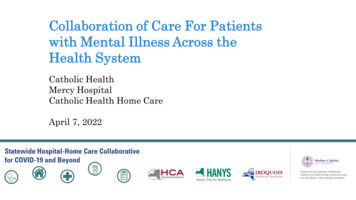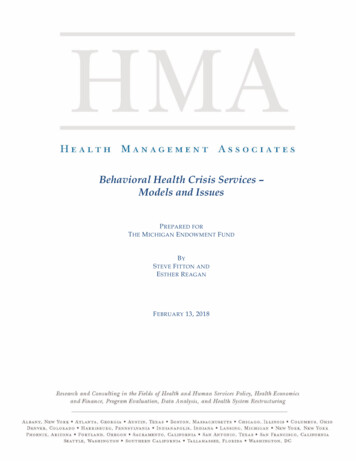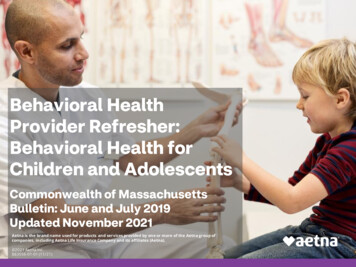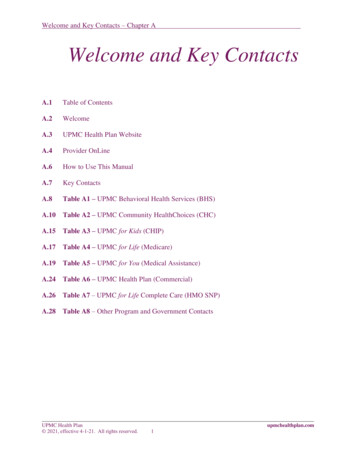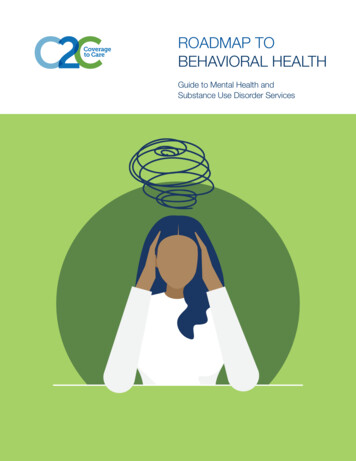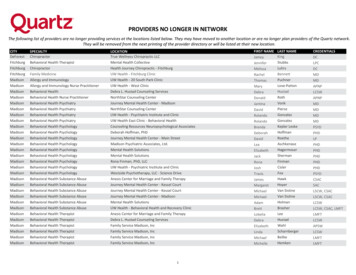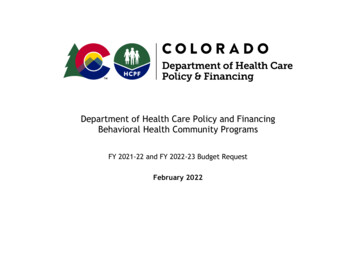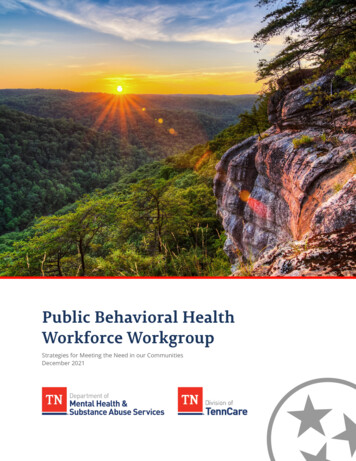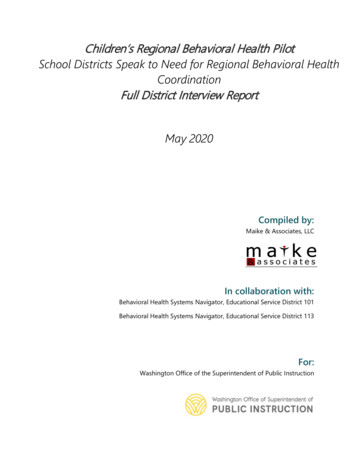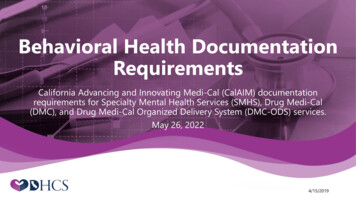
Transcription
Behavioral Health DocumentationRequirementsCalifornia Advancing and Innovating Medi-Cal (CalAIM) documentationrequirements for Specialty Mental Health Services (SMHS), Drug Medi-Cal(DMC), and Drug Medi-Cal Organized Delivery System (DMC-ODS) services.May 26, 20224/15/2019
HousekeepingParticipants are in listen only mode.Please submit questions via the Q&A function. The Chatfeature is disabled.Live closed captioning is available – you can find the link inthe Chat.The webinar slides and recording will be posted to the DHCSCalAIM webpage – please see the link in the Chat.2
Welcome and Introductions4/15/2019
DHCSPresenter» Shaina Zurlin, Chief,Medi-Cal BehavioralHealth4
AgendaLearning ObjectivesDocumentation Redesign BackgroundOverview of Documentation RequirementsNext StepsQ&ABrief PHE Update5
Webinar Learning ObjectivesIdentify keyelements of theupdateddocumentationrequirements.Understand howthe new policymaintains anddiffers fromcurrent policy.Learn where tofind additionalresources.6
How did DHCS Develop the DocumentationRequirements?CalAIM ProposalCalAIM proposalreleased for publiccomment Jan 2021.CalAIM Section 1115Amendmentsubmitted June 2021.AB 133 chaptered July2021.Working GroupOver the past year,DHCS has convenedstakeholders to helpprovide feedbackand inform thedevelopment of thedocumentationrequirements.Public CommentDraft policyreleased inJanuary 2022.DHCS reviewedand integratedstakeholderfeedback.Final PolicyReleased inApril 2022 viaBHIN 22-019.7
Key Documentation RequirementsThree key elements:1. Assessment2. Problem List3. Progress Notes8
Strength-Based ApproachEach element of the documentation requirements have components tohighlight strengths and capture the beneficiary’s perspective.DHCS is using the term “problem list” to align with physical health caresystem language, keeping in mind the goals of care coordination andintegration.Providers are encouraged to use strengths-based approaches that focus on abeneficiary’s unique set of strengths. Services should be provided in the leastrestrictive setting and should prioritize recovery, resiliency, learning,development, and enhanced self-sufficiency.9
AssessmentDMC & DMC-ODSAmerican Societyof AddictionMedicine ( ASAM)CriteriaSMHS for Adults &Youth (beneficiariesunder age 21)AssessmentDomains10
ASAM & CANS»»ASAM will continue to be required for DMC and DMC-ODSbeneficiaries.» Additional information on ASAM criteria requirements can befound in BHIN 21-071 (DMC) and BHIN 21-075 (DMC-ODS).For SMHS beneficiaries under the age of 21, the Child and AdolescentNeeds and Strengths (CANS) Assessment tool may be utilized to helpinform the assessment domain requirements.11
in3Domain4Domain5Domain6Domain7Presenting Problem(s), Current Mental Status,History of Presenting Problem(s), BeneficiaryIdentified Impairments(s)TraumaBehavioral Health History, ComorbidityMedical History, Current Medications,Comorbidity with Behavioral HealthSocial and Life hs, Risk Behaviors, and Safety FactorsClinical Summary and servicerecommendations, ICD Code, Medical NecessityDetermination/Level of Care Access Criteria12
DocumentingMedicalNecessityThe assessment will include theprovider’s determination ofmedical necessity andrecommendation for services.The details within the problemlist and progress notes will alsosupport medical necessity.13
»»Problem ListWill include, but is not limited to:» Diagnoses identified by a provider acting within theirscope of practice, if any.» Problems identified by a provider acting within theirscope of practice, if any.» Problems identified by other providers acting withintheir respective scopes of practice, if any.» Problems identified by the beneficiary and/orsignificant support person, if any.» The name and title of the provider that added orremoved the problem, and the date the problem wasadded or removed.The problem list will be updated on an ongoing basis.14
Elements of a Progress Note»Includes:» The type of service rendered.» A narrative describing how the service addressed the beneficiary’sbehavioral health need.» The date of the service.» Duration of the service, including travel and documentation time.» Location of the beneficiary at the time of receiving the service.» A typed or legibly printed name, signature of the service providerand date of signature.» ICD 10 code, and CPT, or HCPCS code.» Next steps, including, but not limited to, planned action steps by theprovider or by the beneficiary.15
Progress Note Timing»»Progress notes must be completed within 3 business days ofthe service, except for crisis services, which must be completedwithin 24 hours.Providers must complete a daily progress note for services thatare billed daily.» Additional weekly summaries are no longer required for dayrehabilitation and day treatment intensive.16
Progress Notes for GroupServices»For group services, a list of participants is required to bedocumented and maintained by the provider.» If more than one provider renders a group service, oneprogress note may be completed and signed by oneprovider, but it must clearly document the specificinvolvement and time of involvement of each provider.17
Client PlanClient plan requirements have been removed for most SMHS & DMC-ODSservices.Services for which a client plan is still required are noted in Attachment 1 ofBHIN 22-019.Peer Support Services must be based on an approved plan of care. The planof care shall be documented within progress notes.1DHCS is working to update AOD Certification standards to align more closelywith the new documentation requirements.1. State Medicaid Director Letter #07-011; California State Plan, Supp. 3 to Att. 3.1-A, pp.4, 5, 6h, 6i (substance use disorder); p. 2m.1 ocuments/Att-3-1-A-Supp-3.pdf18
»»Targeted Case ManagementTargeted case management services within SMHS require the development andperiodic revision of a care plan that is based on the assessment.2The following required elements must be provided in a narrative format in thebeneficiary’s progress notes for targeted case management services:» Goals, treatment, service activities, and assistance to address the negotiatedobjectives of the plan and the medical, social, educational and other servicesneeded by the beneficiary;» Activities such as ensuring the active participation of the beneficiary, andworking with the beneficiary and others to develop those goals;» A course of action to respond to the assessed needs of the beneficiary; and» Development of a transition plan when a beneficiary has achieved the goals ofthe care plan.2. See California State Plan, Sec. 3, Att. 3.1-A, Supp. 1, pp. 8-17; 42 C.F.R. §19440.169(d)(2) and 42 C.F.R. § 441.18 for guidance.
ComplianceThe new documentation requirementsare effective July 1, 2022.Counties will need to update their policiesand procedures and supporting materialsfor triennial (SMHS) and annual(DMC/DMC-ODS) reviews.20
Technical Assistance Opportunities»»DHCS will be providing TA throughout the year in the form of webinarsand FAQs to assist with the implementation of the CalAIM behavioralhealth policies. Information will be posted on the BH CalAIM webpageand announced via the DHCS Stakeholder Communication Listserv.CalMHSA will also be providing trainings on the updateddocumentation requirements available here.21
What’s Next?FY 2022-2023 Reasons for Recoupment for DMC, DMC-ODS,and SMHS will be developed and updated to align withdocumentation requirements.Standard Screening & Transition Tools go live January 2023.Payment Reform goes live July 2023.22
Q&A23
Public Health Emergency (PHE) Unwinding» The COVID-19 PHE will end soon and millions ofMedi-Cal beneficiaries may lose their coverage.» Top Goal of DHCS: Minimize beneficiary burden and promotecontinuity of coverage for our beneficiaries.» How you can help:» Become a DHCS Coverage Ambassador» Download the Outreach Toolkit on the DHCS Coverage Ambassadorwebpage» Join the DHCS Coverage Ambassador mailing list to receive updatedtoolkits as they become available24
DHCS PHE Unwind CommunicationsStrategy Phase One: Encourage Beneficiaries to Update Contact Information Launch immediately Multi-channel communication campaign to encourage beneficiaries to update contactinformation with county offices.» Flyers in provider/clinic offices, social media, call scripts, website banners Phase Two: Watch for Renewal Packets in the mail. Remember toupdate your contact information! Launch 60 days prior to COVID-19 PHE termination. Remind beneficiaries to watch for renewal packets in the mail and updatecontact information with county office if they have not done so yet.25
» If you have additional questionsQuestions?that we didn’t get to in today’swebinar, please e-mail DHCS at:BHCalAIM@dhcs.ca.gov» Subject Line “DocumentationRequirements”26
Thank You4/15/2019
Reference28
CalAIM Behavioral Health Initiatives TimelineGo-LivePolicyDateCriteria for Specialty Mental Health ServicesJan. 2022Drug Medi-Cal Organized Delivery System 2022-2026Jan. 2022Drug Medi-Cal ASAM Level of Care DeterminationJan. 2022Updated Annual Review Protocol and Reasons for Recoupment FY 2021-2022 Jan. 2022Documentation Redesign for Substance Use Disorder & Specialty MentalJul. 2022Health ServicesNo Wrong Door & Co-Occurring TreatmentJul. 2022Updated Annual Review Protocol and Reasons for Recoupment FY 2022-2023 Oct. 2022Standardized Screening & Transition ToolsJan. 2023Behavioral Health CPT Coding TransitionJul. 2023County Behavioral Health Plans Transition to Fee-for-Service andJul. 2023Intergovernmental TransfersAdministrative Behavioral Health IntegrationJan. 202729
»AdditionalReferences»»»»Medical Necessity Determination andLevel of Care Determination Requirementsfor DMC Treatment Program ServicesBHIN 21-071.DMC-ODS for the Period of 2022 - 2026BHIN 21-075.Criteria for beneficiary access to SMHSBHIN 21-073.Concurrent Review BHIN 22-017Authorization of Outpatient SMHS BHIN22-01630
CalAIM Proposal CalAIM proposal. released for public comment Jan 2021. CalAIM Section 1115 Amendment submitted June 2021. AB 133 chaptered July 2021. Working Group Over the past year, DHCS has convened stakeholders to help provide feedback and inform the development of the documentation requirements. Public Comment Draft policy released in .
